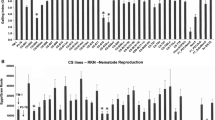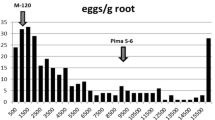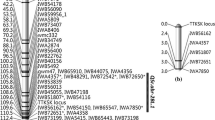Abstract
Host plant resistance is an important strategy for managing root-knot nematode (Meloidogyne incognita) in cotton (Gossypium L.). Here we report evidence for enhanced resistance in interspecific crosses resulting from transgressive segregation of clustered gene loci. Recently, a major gene, rkn1, on chromosome 11 for resistance to M. incognita in cv. Acala NemX was identified using an intraspecific G. hirsutum cross with susceptible cv. Acala SJ-2. Using interspecific crosses of Acala NemX × susceptible G. barbadense cv. Pima S-7, F1, F2, F2:3, backcross, and testcross Acala NemX × F1 (Pima S-7 × SJ-2), parental entries and populations were inoculated in greenhouse tests with M. incognita. Genetic analyses based on nematode-induced root galling and nematode egg production on roots, and molecular marker analysis of the segregating interspecific populations revealed that gene rkn1 interacted with a gene (designated as RKN2) in susceptible Pima S-7 to produce a highly resistant phenotype. RKN2 did not confer resistance in Pima S-7, but when combined with rkn1 (genotype Aa or aa), high levels of resistance were produced in the F1 and segregating F2, F3, and BC1F1 populations. One SSR marker MUCS088 was identified tightly linked to RKN2 within 4.4 cM in a NemX × F1 (Pima S-7 × SJ-2) testcross population. Using mapped SSR markers and interspecific segregating populations, MUCS088 linked to the transgressive gene from the susceptible parent and was located in the vicinity of rkn1 on chromosome 11. Diverse genome analyses among A and D genome diploid and tetraploid cottons revealed that marker MUCS088 (165 and 167 bp) is derived from G. arboreum, A2 diploid genome. These results demonstrated that a highly susceptible parent contributed to nematode resistance via transgressive segregation. Derived highly resistant lines can be used as improved resistance sources in cotton breeding, and MUCS088 can be used to monitor RKN2 introgression in diverse populations. The close genomic location of the transgressive resistance determinants provides an important model system for studying transgressive segregation and epistasis in plants.







Similar content being viewed by others
References
Bayles MB, Verhalen LM, McCall LL, Johnson WM, Barnes BR (2005) Recovery of recurrent parent traits when backcrossing in cotton. Crop Sci 45:2087–2095
Bell MA, Travis MP (2005) Hybridization, transgressive segregation, genetic covariation, and adaptive radiation. Trends Ecol Evol 20:358–361
Bezawada C, Saha S, Jenkins JN, Creech RG, McCarty JC (2003) SSR marker(s) associated with root-knot nematode resistance gene(s) in cotton. J Cotton Sci 7:179–184
Bolek Y, Bell AA, El-Zik KM, Thaxton PM, Magill CW (2005) Reaction of cotton cultivars and an F2 population to stem inoculation with isolates of Verticillium dahliae. J Phytopathol 153:269–273
Bridge J, Page SLJ (1980) Estimation of root-knot nematode infestation levels on roots using a rating chart. Trop Pest Manag 26:296–298
Cherif M, Harrabi M (1993) Transgressive segregation for resistance to Pyrenophora teres in barley. Plant Pathol 42:617–621
De Vicente MC, Tanksley SD (1993) QTL analysis of transgressive segregation in an interspecific tomato cross. Genetics 134:585–596
El Attari H, Rebai A, Hayes PM, Barrault G, Dechamp-Guillaume G, Sarrafi A (1998) Potential of doubled-haploid lines and localization of quantitative trait loci (QTL) for partial resistance to bacterial leaf streak (Xanthomonas campestris pv. hordei) in barley. Theor Appl Genet 96:95–100
Frelichowski JE Jr, Palmer MB, Main D, Tomkins JP, Cantrell RG Stelly DM, Yu J, Kohel RJ, Ulloa M (2006) Cotton genome mapping with new microsatellites from Acala ‘Maxxa’ BAC-ends. Mol Gen Genomics 275:479–491
Goodell PB, Montez GH (1994) Acala cotton tolerance to southern root-knot nematode, Meloidogyne incognita. In: Proc of Beltwide Cotton Prod Res Conf, Natl Cotton Council of Am, Memphis, pp 265–267
Han Z, Wang C, Song X, Guo W, Gou J, Li C, Chen X, Zhang T (2006) Characteristics, development and mapping of Gossypium hirsutum derived EST-SSRs in allotetraploid cotton. Theor Appl Genet 112:430–439
Hu Z, Li P, Zhou M, Zhang Z, Wang L, Zhu L, Zhu Y (2004) Mapping of quantitative trait loci (QTLs) for rice protein and fat content using doubled haploid lines. Euphytica 135:47–54
Hussey RS, Barker KR (1973) A comparision of methods of collecting inocula of Meloidogyne spp. including a new technique. Plant Dis Rep 57:1025–1028
Hyer AH, Jorgenson EC (1984) Root-knot nematode resistance in cotton breeding: techniques and results. In: Proc of Beltwide Cotton Prod Res Conf, Natl Cotton Council of Am, Memphis, pp 377–379
Hyer AH, Jorgenson EC, Garber RH, Smith S (1979) Resistance to root-knot nematode in control of root-knot nematode Fusarium wilt disease complex in cotton Gossypium hirsutum. Crop Sci 19:898–901
Imtiaz M, Cromey MG, Hampton JG, Ahmad M (2003a) Inheritance of seedling resistance to stripe rust (Puccinia striiformis f. sp. tritici) in ‘Otane’ and ‘Tiritea’ wheat (Triticum aestivum). N Zeal J Crop Hortic Sci 31:15–22
Imtiaz M, Cromey MG, Hampton JG, Ahmad M (2003b) Inheritance of durable adult plant resistance to stripe rust (Puccinia striiformis f. sp. tritici) in ‘Otane’ wheat (Triticum aestivum). N Zeal J Crop Hortic Sci 31:23–31
Jenkins JN, Wu J, McCarty JC, Saha S, Gutierrez O, Hayes R, Stelly DM (2006) Genetic effects of thirteen Gossypium barbadense L. chromosome substitution lines in topcrosses with upland cotton cultivars: I. Yield and yield components. Crop Sci 46:1169–1178
Jenkins JN, McCarty JC, Wu J, Saha S, Gutierrez O, Hayes R, Stelly DM (2007) Genetic effects of thirteen Gossypium barbadense L. chromosome substitution lines in topcrosses with upland cotton cultivars: II. Fiber quality traits. Crop Sci 47:561–572
Kohel RJ, Yu J, Park YH, Lazo GR (2001) Molecular mapping and characterization of traits controlling fiber quality in cotton. Euphytica 121:163–172
Lacape JM, Nguyen TB, Thibivilliers S, Bojinov B, Courtois B, Cantrell RG, Burr B, Hau B (2003) A combined RFLP-SSR-AFLP map of tetraploid cotton based on a Gossypium hirsutum x Gossypium barbadense backcross population. Genome 46:612–626
McPherson RG, Jenkins JN, McCarty JC, Watson C (1995) Combining ability analysis of root-knot nematode resistance in cotton. Crop Sci 35:373–375
McPherson MG, Jenkins JN, Watson CE, McCarty JC (2004) Inheritance of root-knot nematode resistance in M-315 RNR and M78-RNR cotton. J Cotton Sci 8:154–161
Michelmore RW, Paran I, Kesseli RV (1991) Identification of markers linked to disease resistance genes by bulked segregant analysis: a rapid method to detect markers in specific genomic regions by using segregating populations. Proc Natl Acad Sci USA 88:9828–9832
Navabi A, Singh RP, Tewari JP, Briggs KG (2004) Inheritance of high levels of adult-plant resistance to stripe rust in five spring wheat genotypes. Crop Sci 44:1156–1162
Nguyen TB, Giband M, Brottier P, Risterucci AM, Lacape JM (2004) Wide coverage of the tetraploid cotton genome using newly developed microsatellite markers. Theor Appl Genet 109:167–175
Oakley SR (1995) CPCSD Acala C-225: a new nematode-resistant Acala variety for California’s San Joaquin Valley. Proc of Beltwide Cotton Prod Res Conf, Natl Cotton Council of Am, Memphis, p 39
Ogallo JL, Goodell PB, Eckert J, Roberts PA (1997) Evaluation of NemX, a new cultivar of cotton with high resistance to Meloidogyne incognita. J Nematol 29:531–537
Park YH, Alabady MS, Sickler B, Wilkins TA, Yu J, Stelly DM, Kohel RJ, El-Shihy OM, Cantrell RG, Ulloa M (2005) Genetic mapping of new cotton fiber loci using EST-derived microsatellites in an interspecific recombinant inbred line (RIL) cotton population. Mol Gen Genomics 274:428–441
Percy RG, Turcotte EL (1988) Development of short and coarse-fibered American Pima cotton for use as parents of interspecific hybrids. Crop Sci 28:913–916
Rieseberg LH, Archer MA, Wayne RK (1999) Transgressive segregation, adaption and speciation. Heredity 83:363–372
Rieseberg LH, Widmer A, Arntz AM, Burke JM (2003) The genetic architecture necessary for transgressive segregation is common in both natural and domesticated populations. Philos Trans R Soc Lond B Biol Sci 358:1141–1147
Robinson AF, Cook CG, Percival AE (1999) Resistance to Rotylenchulus reniformis and Meloidogyne incognita race 3 in the major cotton cultivars planted since 1950. Crop Sci 39:850–858
Shen X, Van Becelaere G, Kumar P, Davis RF, May LO, Chee P (2006) QTL mapping for resistance to root-knot nematodes in the M-120 RNR Upland cotton line (Gossypium hirsutum L.) of the Auburn 623 RNR source. Theor Appl Genet 113:1539–1549
Shepherd RL (1974) Transgressive segregation for root-knot nematode resistance in cotton. Crop Sci 14:872–875
Shepherd RL (1982) Registration of three germplasm lines of cotton. Crop Sci 22:692
Shepherd RL, McCarty JC, Jenkins JN, Parrott WL (1988) Registration of twelve nonphotoperiodic lines with root-knot nematode resistant primitive cotton germplasm. Crop Sci 28:868–869
Shepherd RL, McCarty JC, Jenkins JN, Parrott WL (1996) Registration of nine cotton germplam lines resistant to root-knot nematode. Crop Sci 36:820
Staal J, Kaliff M, Bohman S, Dixelius C (2006) Transgressive segregation reveals two Arabidopsis TIR-NB-LRR resistance genes effective against Leptosphaeria maculans, causal agent of blackleg disease. Plant J 46:218–230
Turcotte EL, Harold WR, O’Bannon JH, Feaster CV (1963) Evaluation of cotton root-knot nematodes resistance of a strain of G. barbadense var. darwinii. Cotton Improve Conf Proc 15:36–44
Van Ooijen JW, Voorrips RE (2001) JoinMap® 3.0, software for the calculation of genetic linkage maps. Plant Research International, Wageningen
Wang C, Roberts PA (2006a) A Fusarium wilt resistance gene in Gossypium barbadense and its effect on root-knot nematode–wilt disease complex. Phytopathology 96:727–734
Wang C, Roberts PA (2006b) Development of AFLP and derived CAPS markers for root-knot nematode resistance in cotton. Euphytica 152:185–196
Wang C, Ulloa M, Roberts PA (2006a) Identification and mapping of microsatellite markers linked to a root-knot nematode resistance gene (rkn1) in Acala NemX cotton (Gossypium hirsutum L.). Theor Appl Genet 112:770–777
Wang C, Matthews WC, Roberts PA (2006b) Phenotypic expression of rkn1-mediated Meloidogyne incognita resistance in Gossypium hirsutum populations. J Nematol 38:250–257
Wang K, Song X, Han Z, Guo W, Yu JZ, Sun J, Pan J, Kohel RJ, Zhang T (2006c) Complete assignment of the chromosomes of Gossypium hirsutum L. by translocation and fluorescence in situ hybridization mapping. Theor Appl Genet 113:73–80
Watanabe H, Futakuchi K, Jones MP, Sobambo BA (2006) Grain protein content of interspecific progenies derived from the cross of African rice (Oryza glaberrima Steud.) and Asian rice (Oryza sativa L.). Plant Production Sci 9:287–293
Winter SM, Shelp BJ, Anderson TR, Welacky TW, Rajcan I (2007) QTL associated with horizontal resistance to soybean cyst nematode in Glycine soja PI464925B. Theor Appl Genet 114:461–472
Ynturi P, Jenkins JN, McCarty JC Jr, Gutierrez OA, Saha S (2006) Association of root-knot nematode resistance genes with simple sequence repeat markers on two chromosomes in cotton. Crop Sci 46:2670–2674
Yu ZH, Kohel RJ (2001) Cotton genome research in the United States. In: Jenkins JN, Saha S (eds) Genetic improvement of cotton technologies: emerging technologies. Science Publisher Inc, Enfield, pp 103–121
Zhang ZJ, Yang GH, Li GH, Jin SL, Yang XB (2001) Transgressive segregation, heritability, and number of genes controlling durable resistance to stripe rust in one Chinese and two Italian wheat cultivars. Phytopathology 91:680–686
Zhao G, Ablett GR, Anderson TR, Rajcan I, Schaafsma AW (2005) Inheritance and genetic mapping of resistance to Rhizoctonia root and hypocotyl rot in soybean. Crop Sci 45:1441–1447
Acknowledgments
This study was funded in part by a Cooperative Research Agreement from Cotton Incorporated and a grant from the University of California Discovery Grant (BioSTAR) Program. The authors thank Steven Oakley, James Starr, California Planting Cotton Seed Distributors, and USDA Cotton Germplasm Center for providing cotton seed, Mikeal Roose for helpful advice, and Kathie Carter, Sherry Ellberg, William Matthews, and Teresa Mullens for technical help. Names are necessary to report factually in available data, however, the USDA neither guarantees nor warrants the standard of products or service, and the use of the name by the USDA implies no approval of the product or service to the exclusion of others that may also be suitable.
Author information
Authors and Affiliations
Corresponding author
Additional information
Communicated by K. Shirasu.
Rights and permissions
About this article
Cite this article
Wang, C., Ulloa, M. & Roberts, P.A. A transgressive segregation factor (RKN2) in Gossypium barbadense for nematode resistance clusters with gene rkn1 in G. hirsutum . Mol Genet Genomics 279, 41–52 (2008). https://doi.org/10.1007/s00438-007-0292-3
Received:
Accepted:
Published:
Issue Date:
DOI: https://doi.org/10.1007/s00438-007-0292-3




